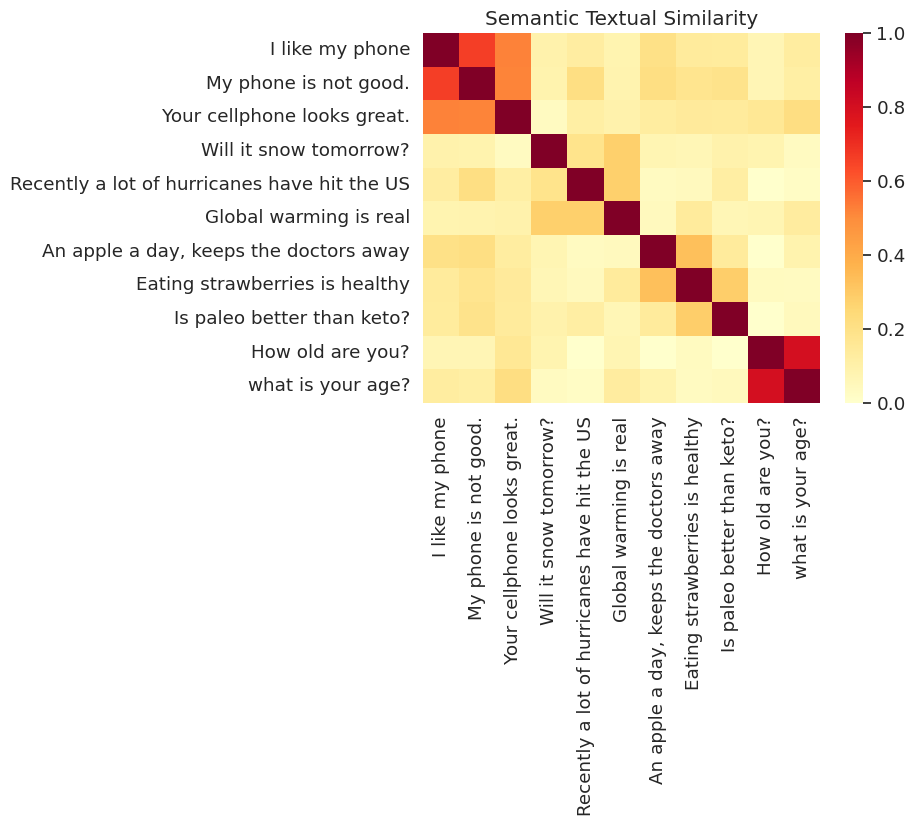 Xem trên TensorFlow.org Xem trên TensorFlow.org |  Chạy trong Google Colab Chạy trong Google Colab |  Xem trên GitHub Xem trên GitHub |  Tải xuống sổ ghi chép Tải xuống sổ ghi chép |  Xem các mẫu TF Hub Xem các mẫu TF Hub |
Sổ tay này minh họa cách truy cập Bộ mã hóa câu đa năng và sử dụng nó cho các nhiệm vụ tương tự câu và phân loại câu.
Bộ mã hóa câu đa năng giúp cho việc nhúng cấp độ câu trở nên dễ dàng như trước đây để tra cứu các bản nhúng cho các từ riêng lẻ. Sau đó, các thao tác nhúng câu có thể được sử dụng để tính toán mức độ tương đồng về ý nghĩa của câu cũng như để cho phép thực hiện tốt hơn các nhiệm vụ phân loại hạ lưu bằng cách sử dụng dữ liệu huấn luyện ít được giám sát hơn.
Thành lập
Phần này thiết lập môi trường để truy cập vào Bộ mã hóa câu đa năng trên TF Hub và cung cấp các ví dụ về việc áp dụng bộ mã hóa cho các từ, câu và đoạn văn.
%%capture
!pip3 install seaborn
Biết thêm thông tin chi tiết về việc cài đặt Tensorflow có thể được tìm thấy tại https://www.tensorflow.org/install/ .
Tải mô-đun TF Hub của Bộ mã hóa câu đa năng
from absl import logging
import tensorflow as tf
import tensorflow_hub as hub
import matplotlib.pyplot as plt
import numpy as np
import os
import pandas as pd
import re
import seaborn as sns
module_url = "https://tfhub.dev/google/universal-sentence-encoder/4"
model = hub.load(module_url)
print ("module %s loaded" % module_url)
def embed(input):
return model(input)
module https://tfhub.dev/google/universal-sentence-encoder/4 loaded
Tính toán đại diện cho mỗi tin nhắn, hiển thị các độ dài khác nhau được hỗ trợ.
word = "Elephant"
sentence = "I am a sentence for which I would like to get its embedding."
paragraph = (
"Universal Sentence Encoder embeddings also support short paragraphs. "
"There is no hard limit on how long the paragraph is. Roughly, the longer "
"the more 'diluted' the embedding will be.")
messages = [word, sentence, paragraph]
# Reduce logging output.
logging.set_verbosity(logging.ERROR)
message_embeddings = embed(messages)
for i, message_embedding in enumerate(np.array(message_embeddings).tolist()):
print("Message: {}".format(messages[i]))
print("Embedding size: {}".format(len(message_embedding)))
message_embedding_snippet = ", ".join(
(str(x) for x in message_embedding[:3]))
print("Embedding: [{}, ...]\n".format(message_embedding_snippet))
Message: Elephant Embedding size: 512 Embedding: [0.008344474248588085, 0.00048079612315632403, 0.06595245748758316, ...] Message: I am a sentence for which I would like to get its embedding. Embedding size: 512 Embedding: [0.05080860108137131, -0.016524313017725945, 0.015737781301140785, ...] Message: Universal Sentence Encoder embeddings also support short paragraphs. There is no hard limit on how long the paragraph is. Roughly, the longer the more 'diluted' the embedding will be. Embedding size: 512 Embedding: [-0.028332678601145744, -0.05586216226220131, -0.012941479682922363, ...]
Ví dụ về nhiệm vụ tương đồng về ngữ nghĩa văn bản
Các bản nhúng do Bộ mã hóa câu đa năng tạo ra gần như được chuẩn hóa. Sự giống nhau về ngữ nghĩa của hai câu có thể được tính là sản phẩm bên trong của các bảng mã.
def plot_similarity(labels, features, rotation):
corr = np.inner(features, features)
sns.set(font_scale=1.2)
g = sns.heatmap(
corr,
xticklabels=labels,
yticklabels=labels,
vmin=0,
vmax=1,
cmap="YlOrRd")
g.set_xticklabels(labels, rotation=rotation)
g.set_title("Semantic Textual Similarity")
def run_and_plot(messages_):
message_embeddings_ = embed(messages_)
plot_similarity(messages_, message_embeddings_, 90)
Hình ảnh giống nhau
Ở đây chúng tôi cho thấy sự tương tự trong một bản đồ nhiệt. Đồ thị cuối cùng là một ma trận 9x9 nơi mỗi mục [i, j] là màu dựa trên sản phẩm bên trong của mã hóa cho câu i và j .
messages = [
# Smartphones
"I like my phone",
"My phone is not good.",
"Your cellphone looks great.",
# Weather
"Will it snow tomorrow?",
"Recently a lot of hurricanes have hit the US",
"Global warming is real",
# Food and health
"An apple a day, keeps the doctors away",
"Eating strawberries is healthy",
"Is paleo better than keto?",
# Asking about age
"How old are you?",
"what is your age?",
]
run_and_plot(messages)

Đánh giá: Điểm chuẩn STS (Sự giống nhau về ngữ nghĩa văn bản)
Các STS Benchmark cung cấp một đánh giá nội tại của mức độ mà điểm tương đồng tính sử dụng câu embeddings class với phán đoán của con người. Điểm chuẩn yêu cầu các hệ thống trả về điểm tương tự cho các cặp câu được lựa chọn đa dạng. Pearson tương quan sau đó được sử dụng để đánh giá chất lượng của các điểm số máy giống nhau chống lại phán quyết của con người.
Tải xuống dữ liệu
import pandas
import scipy
import math
import csv
sts_dataset = tf.keras.utils.get_file(
fname="Stsbenchmark.tar.gz",
origin="http://ixa2.si.ehu.es/stswiki/images/4/48/Stsbenchmark.tar.gz",
extract=True)
sts_dev = pandas.read_table(
os.path.join(os.path.dirname(sts_dataset), "stsbenchmark", "sts-dev.csv"),
error_bad_lines=False,
skip_blank_lines=True,
usecols=[4, 5, 6],
names=["sim", "sent_1", "sent_2"])
sts_test = pandas.read_table(
os.path.join(
os.path.dirname(sts_dataset), "stsbenchmark", "sts-test.csv"),
error_bad_lines=False,
quoting=csv.QUOTE_NONE,
skip_blank_lines=True,
usecols=[4, 5, 6],
names=["sim", "sent_1", "sent_2"])
# cleanup some NaN values in sts_dev
sts_dev = sts_dev[[isinstance(s, str) for s in sts_dev['sent_2']]]
/tmpfs/src/tf_docs_env/lib/python3.7/site-packages/IPython/core/interactiveshell.py:3444: FutureWarning: The error_bad_lines argument has been deprecated and will be removed in a future version. exec(code_obj, self.user_global_ns, self.user_ns)
Đánh giá Nhúng câu
sts_data = sts_dev
def run_sts_benchmark(batch):
sts_encode1 = tf.nn.l2_normalize(embed(tf.constant(batch['sent_1'].tolist())), axis=1)
sts_encode2 = tf.nn.l2_normalize(embed(tf.constant(batch['sent_2'].tolist())), axis=1)
cosine_similarities = tf.reduce_sum(tf.multiply(sts_encode1, sts_encode2), axis=1)
clip_cosine_similarities = tf.clip_by_value(cosine_similarities, -1.0, 1.0)
scores = 1.0 - tf.acos(clip_cosine_similarities) / math.pi
"""Returns the similarity scores"""
return scores
dev_scores = sts_data['sim'].tolist()
scores = []
for batch in np.array_split(sts_data, 10):
scores.extend(run_sts_benchmark(batch))
pearson_correlation = scipy.stats.pearsonr(scores, dev_scores)
print('Pearson correlation coefficient = {0}\np-value = {1}'.format(
pearson_correlation[0], pearson_correlation[1]))
Pearson correlation coefficient = 0.8036394630692778 p-value = 0.0

